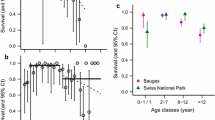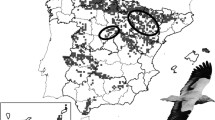Abstract
Many polygynous ungulates show higher mortality of males than of females, because of the intense male-male competition during the rut and the costs associated with the development of sexual-size dimorphism. In the weakly dimorphic Alpine chamois Rupicapra rupicapra the occurrence of differential sex-specific survival strategies is controversial. To date, only two studies investigated the survivorship of males and females in this species,producing conflicting results: these works, based on the use of life tables, require confirmation from researches carried out on living populations. We assessed the survival pattern of a protected Alpine chamois population in the Swiss National Park, where 116 individuals were marked and monitored over 13 years (1996–2008). We tested for sex-, age- and year-dependence of survival by means of capture-mark-resight models. Resighting probabilities were sex-dependent, and survival rates were time-dependent. Females had higher resighting probabilities (0.84) than males (0.74). All over the time periods, sex had a weak influence on survival probability (males=0.91; females=0.92) and survival rates remained surprisingly high until late age (1 year=0.90; 2–7 years=0.91; 8+ years=0.92). The growing evidence for a high adult survival and a weak differential mortality of the two sexes, together with the highly seasonal sexual-size dimorphism observed for Alpine chamois, might indicate the occurrence of a unique conservative survival strategy in both sexes and a low-risk mating strategy by males.
Similar content being viewed by others
References
Akaike, H., 1973. Informationtheory andextension of the maximum likelihood principle. In: Second International Symposium on Information Theory. Akademia Kaido, Budapest, Hungary, pp. 267–281.
Bassano, B., Perrone, A., von Hardenberg, A., 2003. Body weight and horn develop-mentinAlpine chamois, Rupicapra rupicapra (Bovidae, Caprinae). Mammalia 67, 65–73.
Bertolino, S., 2003. Herd defensive behaviour of chamois, Rupicapra rupicapra, in response to predation on the young by a golden eagle, Aquila chrysaetos. Z. Jagdwiss. 49, 233–236.
Bocci, A., Canavese, G., Lovari, S., 2010. Even mortality patterns of the two sexes in a polygynous, near-monomorphic species: is there a flaw? J. Zool. Lond. 280, 379–386.
Boer, A.H., 1988. Mortality rate of moose in New Brunswick: a life table analysis. J. Wildl. Manage. 52, 21–25.
Bruno, E., Lovari, S., 1989. Foraging behaviour of adult female Apennine chamois in relation to the seasonal variation in food supply. Acta Theriol. 34–37, 513–523.
Burnham, K.P., Anderson, D.R., 2002. Model Selection and Multimodel Inference, second ed. Springer, New York.
Caughley, G., 1966. Mortality patterns in mammals. Ecology 47, 906–918.
Ciucci, P., Chapron, G., Guberti, V., Boitani, L., 2007. Estimation of mortality parameters from (biased) samples at death: are we getting the basics right in wildlife field studies? A response to Lovari et al. (2007). J. Zool. Lond. 272, 125–127.
Clutton-Brock, T.H., Isvaran, K., 2007. Sex differences inageing in natural populations of vertebrates. Proc. R. Soc. B 274, 3097–3104.
Clutton-Brock, T.H., Albon, S.D., Guinness, F.E., 1985. Parental investment and sex differences in juvenile mortality in birds and mammals. Nature 313, 131–133.
Clutton-Brock, T.H., Guinness, F.E., Albon, S.D., 1982. Red Deer. Behavior and Ecology of Two Sexes. University of Chicago Press, Chicago, IL.
Festa-Bianchet, M., Gaillard, J.-M., Côté, S.D., 2003. Variable age structure and apparent density dependence insurvival ofadult ungulates.J.Anim. Ecol. 72, 640–649.
Filli, F., 2006. Ungulate research in the Swiss National Park: development, current issues and future challenges. In: Filli, F., Suter, W.(Eds.), Nationalpark-Forschung in der Schweiz, vol. 93. Zernez, Switzerland, pp. 9–29.
Gaillard, J.-M., Festa-Bianchet, M., Yoccoz, N.G., Loison, A., Toïgo, C., 2000. Temporal variation in fitness components and population dynamics of large herbivores. Ann. Rev. Ecol. Syst. 31, 367–393.
Garel, M., Loison, A., Jullien, J.-M., Dubray, D., Maillard, D., Gaillard, J.-M., 2009. Sex-specific growth in alpine chamois. J. Mammal 90, 954–960.
Gauthier, D., Michallet, J., 1993. Bilan des expériences franc¸ aises en matière de capture par engin du Bouquetin des Alpes Capra i. Ibex. In: Dubray, D (Ed.), Techniques de Capture et de Marquage des Ongulés Sauvages. Office National de la Chasse, Montpellier.
Gonzalez, G., Crampe, J.-P., 2001. Mortality patterns in a protected population of isards (Rupicapra pyrenaica). Can. J. Zool. 79, 2072–2079.
Haller, H., 2006. Der schweizerische nationalpark. In: Konold, W., Böcker, R., Hampicke, U. (Eds.), Handbuch Naturschutz und Landschaftspflege. Landsberg.
Isaac, J.L., 2005. Potential causes and life-history consequences of sexual size dimorphism in mammals. Mamm. Rev. 35, 101–115.
Krämer, A., 1969. Soziale organisation und sozialverhalten einer gemspopulation Rupicapra rupicapra der Alpen. Z. Tierpsychol. 26, 889–964.
Krebs, C.J., 1999. Ecological Methodology. Addison Wesley Longman, Menlo Park CA.
Laake, J., Rexstad, E., 2008. In: Cooch, E., White, G.C. (Eds.), RMark – An alternative approach to building linear models in MARK.(AppendixC).,seventhed.Program MARK: A Gentle Introduction.
Lande, R., Engen, S., Sæther, B.-E., Filli, F., Matthysen, E., Weimerskirch, H., 2002. Estimating density dependence from population time series using demographic theory and life-history data. Am. Nat. 159, 321–337.
Lebreton, J.-D., Burnham, K.P., Anderson, D.R., Clobert, J., 1992. Modeling survival and testing biological hypotheses using marked animals: a unified approach with case studies. Ecol. Monogr. 62, 67–118.
Loison, A., Gaillard, J.-M., Houssin, H., 1994. New insight on survivorship of female chamois (Rupicapra rupicapra) from observationof marked animals. Can. J.Zool. 72, 591–597.
Loison, A., Festa-Bianchet, M., Gaillard, J.-M., Jorgenson, J.T., Jullien, J.-M., 1999. Age-specific survival in five populations of ungulates: evidence of senescence. Ecology 80, 2539–2554.
Oehlert, G.W., 2010. A note on the delta method. Am. Stat. 46, 27–29.
Pérez-Barberìa, F.G., Mutuberrìa, G., Nores, C., 1998. Reproductive parameters, kidney fat index, and grazing activity relationships between the sexesin Cantabrian chamois Rupicapra pyrenaica parva. Acta Theriol. 43, 311–324.
Promislow, D.E.L., 1992. Costs of sexual selection innatural populationof mammals. Proc. R. Soc. Lond. B 247, 203–210.
R Development Core Team, 2011. R: A Language and Environment for Statistical Computing (2.12.2). R Foundation for Statistical Computing.
Rughetti, M., Festa-Bianchet, M., 2010. Compensatory growth limits opportunities for artificial selection in Alpine chamois. J. Wildl. Manage. 74, 1024–1029.
Rughetti, M., Festa-Bianchet, M., 2011. Seasonal changes in sexual-size dimorphism in northern chamois. J. Zool. Lond. 284, 257–264.
Schröder, W., 1971. Untersuchungen zur okologie des gamswildes (Rupicapra rupi-capra) in einen vorkommen der Alpen. Z. Jagdwiss. 17, 114–166.
Schröder, W., Elsner-Schack, I.V., 1985. Correct age determination in chamois. In: Lovari, S. (Ed.), The Biology and Management of Mountain Ungulates. Croom Helm, London, pp. 67–70.
Stearns, S.C., 1992. The Evolution of Life-Histories. Oxford University Press, Oxford.
Toïgo, C., Gaillard, J.-M., 2003. Causes of sex-biased adult survival in ungulates: sexual size dimorphism, mating tactic or environmental harshness? Oikos 101, 376–384.
Toïgo, C., Gaillard, J.-M., Festa-Bianchet, M., Largo, E., Michallet, J., Maillard, D., 2007. Sex- and age-specific survival of the highly dimorphic Alpine ibex: evidence for a conservative life-history tactic. J. Anim. Ecol. 76, 679–686.
von Hardenberg, A., Bassano, B., Peracino, A., Lovari, S., 2000. Male Alpine chamois occupy territories at hotspots before the mating season. Ethology 106, 617–630.
White, G.C., Burnham, K.P., 1999. Program MARK: Survival estimation from populations of marked animals. Bird Study 46, 120–138.
Zoller, H., 1995. Vegetationskarte des Schweizerischen Nationalparks. Kommission der Schweizerischen Akademie der Naturwissenschaften SANW zur Wis-senschaftlichen Erforschung des Nationalparks (WNPK). Zernez, Nr. 85.
Author information
Authors and Affiliations
Corresponding author
Rights and permissions
About this article
Cite this article
Corlatti, L., Lebl, K., Filli, F. et al. Unbiased sex-specific survival in Alpine chamois. Mamm Biol 77, 135–139 (2012). https://doi.org/10.1016/j.mambio.2011.09.007
Received:
Accepted:
Published:
Issue Date:
DOI: https://doi.org/10.1016/j.mambio.2011.09.007




